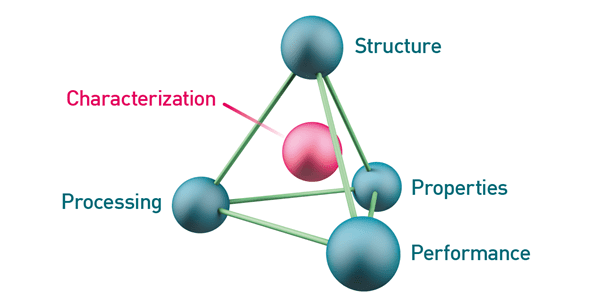Materials science is a scientific field that studies the structure, properties, and behavior of various materials. Science is at the core of materials science, as the field utilizes scientific principles and methods to investigate and understand the properties and behavior of materials at the atomic and molecular level.
Materials scientists use scientific techniques and tools such as microscopy, spectroscopy, and computational modeling to examine and analyze the composition and behavior of different materials. Through their research, they seek to understand how materials are formed, how they can be modified or synthesized, and how they can be applied to create new technologies and improve existing ones.
The field of materials science is interdisciplinary, combining elements of physics, chemistry, engineering, and other sciences to understand and manipulate the properties of materials. By studying the science behind materials, materials scientists are able to create new and innovative materials that have unique properties and applications.

Materials for energy :
Materials science plays a crucial role in the development and utilization of materials for energy applications. The field involves the scientific investigation and design of materials that can efficiently convert, store, and transfer energy.
One example of materials science in energy is the development of new materials for solar energy conversion. Scientists use their knowledge of the science behind materials to create photovoltaic materials that can efficiently convert sunlight into electrical energy. By studying the properties and behavior of materials at the atomic and molecular level, researchers can design new materials that have enhanced light absorption, improved charge transport, and longer device lifetimes.
Another example of materials science in energy is the design of materials for energy storage applications. Materials scientists study the science behind materials to develop new battery materials that can store energy efficiently and reliably. By understanding the properties of materials at the nanoscale level, scientists can design new materials with high energy density, long cycle life, and improved safety.
Overall, the science of materials plays a vital role in the development of materials for energy applications. By understanding the properties and behavior of materials at the atomic and molecular level, materials scientists are able to design new materials that can efficiently convert, store, and transfer energy, paving the way for a more sustainable future.

Classification of energy-related materials :
Energy-related materials can be classified based on their properties, functions, and applications.
- Solar Energy Materials – These are materials that are designed to absorb sunlight and convert it into electrical energy. They can be classified based on their optical, electronic, and transport properties.
- Battery Materials – These are materials that are used to store and release electrical energy. They can be classified based on their electrochemical properties, such as their charge storage capacity, rate capability, and cycle life.
- Thermoelectric Materials – These are materials that can convert heat into electrical energy. They can be classified based on their thermoelectric properties, such as their Seebeck coefficient, electrical conductivity, and thermal conductivity.
- Fuel Cell Materials – These are materials that are used to convert chemical energy into electrical energy. They can be classified based on their electrochemical properties, such as their ion conductivity, catalytic activity, and stability.
- Energy Storage Materials – These are materials that are used to store energy in various forms, such as electrical, chemical, or thermal energy. They can be classified based on their specific energy, power density, and energy efficiency.
- Energy Conversion Materials – These are materials that are used to convert energy from one form to another, such as from mechanical energy to electrical energy. They can be classified based on their mechanical, electrical, and thermal properties.
Overall, the classification of energy-related materials using science keywords provides a useful framework for understanding the properties and behavior of these materials and their potential applications in various energy-related technologies.
Applications of energy-related materials:
Energy-related materials have a wide range of applications in various fields, including renewable energy, transportation, and electronics.
- Solar Energy Materials – These materials are used in solar cells to convert sunlight into electrical energy. They are also used in solar thermal systems to convert sunlight into heat for various applications, such as space heating and water heating.
- Battery Materials – These materials are used in batteries for energy storage in various applications, such as electric vehicles, portable electronics, and grid-scale energy storage systems.
- Thermoelectric Materials – These materials are used in thermoelectric generators to convert waste heat into electrical energy in various applications, such as power generation in automobiles and industrial processes.
- Fuel Cell Materials – These materials are used in fuel cells to convert chemical energy into electrical energy in various applications, such as backup power for telecommunications and remote locations, as well as in transportation and stationary power generation.
- Energy Storage Materials – These materials are used in various energy storage systems, such as capacitors, supercapacitors, and flow batteries, to store energy for various applications, including grid-scale energy storage and portable electronics.
- Energy Conversion Materials – These materials are used in various energy conversion systems, such as generators, motors, and transformers, to convert energy from one form to another in various applications, including transportation and power generation.
- Overall, the applications of energy-related materials using science keywords highlight their importance in various fields and their potential to contribute to a more sustainable and efficient energy future.
Materials for ground transportation :
Materials science plays a vital role in developing materials for ground transportation, including cars, trucks, buses, and trains. The choice of materials affects the performance, safety, fuel efficiency, and environmental impact of these vehicles.
- Lightweight Materials – Lightweight materials such as aluminum, magnesium, and carbon fiber reinforced polymers (CFRPs) are used to reduce the weight of vehicles and improve their fuel efficiency. They are also used to improve the vehicle’s handling and acceleration.
- Advanced Composites – Advanced composites such as fiberglass, aramid fibers, and high-performance thermoplastics are used to enhance the stiffness and strength of vehicle components such as chassis, body panels, and interior parts. These materials provide excellent fatigue resistance and durability, leading to longer vehicle lifetimes.
- High-Strength Steels – High-strength steels such as advanced high-strength steel (AHSS) and ultra-high-strength steel (UHSS) are used to improve the crashworthiness of vehicles while reducing their weight. These materials offer high strength-to-weight ratios and are widely used in vehicle body structures.
- Polymer-Based Materials – Polymer-based materials such as thermoplastics and elastomers are used in various automotive applications, such as hoses, gaskets, seals, and insulation. These materials offer excellent chemical resistance, durability, and flexibility.
- Smart Materials – Smart materials such as shape-memory alloys and piezoelectric materials are used in various automotive applications, such as sensors, actuators, and vibration damping systems. These materials can sense and respond to changes in the environment, leading to improved performance and safety.
Overall, the development of materials for ground transportation using science keywords leads to improved performance, fuel efficiency, safety, and sustainability of vehicles. The use of lightweight materials, advanced composites, high-strength steels, polymer-based materials, and smart materials provides a wide range of solutions to meet the evolving needs of the transportation industry.










